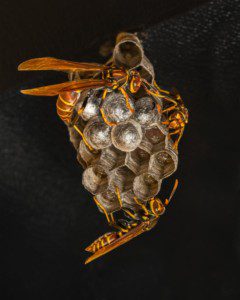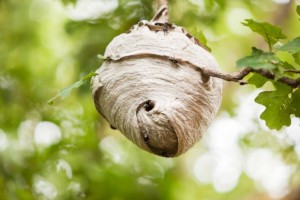Wasp and Nest Removal
We humans have a love-hate relationship with wasps and bees. Wasps are important pollinators and keep many pest populations in check. Unfortunately wasps can be a serious nuisance by invading our structures and stinging us.
Wasps are a super diverse group of insects with over 100,000 species worldwide. They are very closely related to both ants and bees. Wasps can either be social or solitary. Social wasps live and work together in colonies. They not only help raise the young cooperatively they also attack together. These are typically the ones that pest control companies get called out for because nests can be large and the wasps might have stung someone. Wasps that are solitary don’t live together or help each other but they may cluster in the same area exploiting a good resource. Here are some of the most common social wasps you may find around your home.
Need Help With Wasp and Nest Removal?
Yellow Jackets
 These wasps are very common in early fall and start to become a real nuisance. They are about ½ in long with yellow and black bands on their bodies. In the spring new queens that have been overwintering come out and start making new nests. They build their paper nests in the ground like old rodent burrow, or in building cavities. These social wasps leave the nest looking for food for their young larvae back at the nest. During the fall the food source starts to decrease and in desperation and anger they bring us in a lot more contact with these potentially large nests. At the end of the season, the colonies die, the new queens overwinter and in the spring it starts all over again. Removing a Yellow Jacket nest should be left to the professionals, especially if they are in a cavity of your home.
These wasps are very common in early fall and start to become a real nuisance. They are about ½ in long with yellow and black bands on their bodies. In the spring new queens that have been overwintering come out and start making new nests. They build their paper nests in the ground like old rodent burrow, or in building cavities. These social wasps leave the nest looking for food for their young larvae back at the nest. During the fall the food source starts to decrease and in desperation and anger they bring us in a lot more contact with these potentially large nests. At the end of the season, the colonies die, the new queens overwinter and in the spring it starts all over again. Removing a Yellow Jacket nest should be left to the professionals, especially if they are in a cavity of your home.
Paper Wasps
 These are some of the most common wasps we find on our homes and businesses. They are really not that aggressive, but can cause issues as the nests grow through the season. Unlike Yellow Jackets that have protected nests that are built underground or in walls, Paper Wasps build paper nests that are exposed and attached normally to eaves or overhangs. Their nests are a single comb that they fill with their young, or larvae. Adults prey on other insects, especially caterpillars. At the end of the season, the old nest dies off, the new queens overwinter, and in the spring it starts all over again.
These are some of the most common wasps we find on our homes and businesses. They are really not that aggressive, but can cause issues as the nests grow through the season. Unlike Yellow Jackets that have protected nests that are built underground or in walls, Paper Wasps build paper nests that are exposed and attached normally to eaves or overhangs. Their nests are a single comb that they fill with their young, or larvae. Adults prey on other insects, especially caterpillars. At the end of the season, the old nest dies off, the new queens overwinter, and in the spring it starts all over again.
Bald Faced Hornets
 These are some of the most aggressive wasps that we encounter. They are about ¾ inch long, mostly black, with white marking on their face and tip of their abdomen. They also build their nests out of paper but normally hang these nests from tree limbs and sometimes from a structure or in an attic. Just like the other two, in the spring a new queen comes out and starts a new nests and as the season progresses the nests get bigger and more of a nuisance.
These are some of the most aggressive wasps that we encounter. They are about ¾ inch long, mostly black, with white marking on their face and tip of their abdomen. They also build their nests out of paper but normally hang these nests from tree limbs and sometimes from a structure or in an attic. Just like the other two, in the spring a new queen comes out and starts a new nests and as the season progresses the nests get bigger and more of a nuisance.
Wasp Management
- Smithereen will first do a thorough inspection of the property to determine the species of wasp and exactly where the nest is located.
- If the nest is in the ground, the technician will treat the nest directly.
- If the nest is in a wall void, Smithereen will treat that cavity through the exterior access point. It is very important that if the nests is in the structure it is removed from the cavity so there are no issues later with other pests.